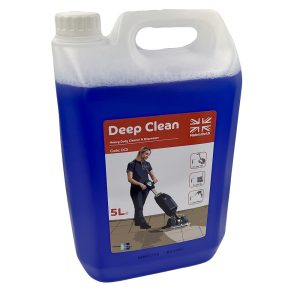Scrubbing machines, also known as floor scrubbers, have revolutionised the way we maintain floors. These machines are not just cleaning tools; they are a testament to innovation and progress in the cleaning industry.
Scrubbing machines means less work for cleaners, gone are the days of scrubbing on your hands and knees. Which makes the cleaners happy 😄
They also mean less time spent cleaning, which is the biggest factor for business owners when looking into new machinery. Good cleaners are hard to come by so they need to make sure they’re using their time effectively.
In the world of modern cleaning technology, efficiency, effectiveness, and hygiene are paramount.
Rotary Floor Scrubbing Machines
For centuries, mopping and floor scrubbing were the go-to methods for maintaining clean and presentable floors. However, the introduction of rotary scrubbers marked a significant turning point in the world of floor care. In this topic, we will explore how rotary scrubbers revolutionised floor maintenance, the mechanics behind their operation, and the role of water, chemicals, and wet vacuums in this transformative process.
The Era of Mopping and Traditional Floor Scrubbing:
For many years, mopping and manual floor scrubbing were the primary means of keeping floors clean. This labour-intensive approach involved the use of a mop or scrubbing brush, water, and cleaning chemicals. While effective to a certain extent, it had limitations in terms of efficiency, especially for large commercial and industrial spaces.
Enter the Rotary Scrubber:
The rotary scrubber, also known as the floor buffer or floor polisher, emerged as a game-changer in the mid-20th century. This machine featured a rotating cylindrical brush or pad that rapidly cleaned and polished floors. Its introduction significantly reduced the reliance on traditional mopping methods.
How Rotary Scrubbers Work:
Rotary scrubbers are powered by mains or battery-powered motor that drives the brush or pad in a circular motion. The bristles or pads make contact with the floor surface, agitating and removing dirt and grime.
Watch this video to understand how to operate a rotary.
There are 3 main ways that rotary floor machines can be used:
1 – Spray Cleaning/Buffing with a Rotary Machine:
In spray cleaning the user sprays a small amount of a cleaner/polish onto a smooth floor. The rotary machine is fitted with a blue or red pad. As the floor machine is worked over the floor, the dirt goes up into the pad & a slight sheen is left on the floor
2 – Burnishing:
This is a similar process to spray buffing but the machine spins much faster & a softer pad is used. The motion is front to back rather than side to side. Burnishing leaves a high gloss & more protection on the floor. It is not as good at removing dirt as spray cleaning.
Please note both of these methods are not as popular as they once were, this is mainly because:
- Shiny floors are not as fashionable as they once were.
- Glossy floors are perceived to be slippery.
- Most new floors have a rough texture that reduces slips & these 2 methods only work on smooth floors.
See this video for an explanation of the 2 methods above.
3 – Wet Scrubbing with a Rotary Machine:
For more thorough cleaning, rotary scrubbers can be used with lots of water and cleaning chemicals. The user mixes up water & a cleaning chemical such as Ubik 2000. The solution is mopped onto the floor, or if the machine has a tank this can be used to dispense the solution. The rotating brush or a green pad agitates the floor, effectively breaking down ingrained dirt and stains. That dirt that has been scrubbed out of the floor is then in a slurry of dirty water. Before that water dries you must remove it from the floor.
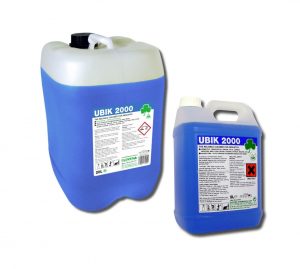
There are 3 ways of removing this dirty water:
- If there is a floor drain use a floor squeegee to squeegee the water away.
- Use a wet vacuum to suck it up (this is the most effective as a drier floor means a cleaner floor).
- Use a socket mop or a Kentucky mop to mop it up.
Conclusion:
The advent of rotary scrubbers brought a revolutionary change to floor care, replacing traditional mopping in many commercial and industrial settings. Their efficiency, versatility, and ability to work with or without water and chemicals have made them indispensable tools in the modern cleaning arsenal. The addition of wet vacuums further enhances the effectiveness of this transformative floor maintenance method.
Categorising Rotary Scrubbing Machines
In this topic, we will be categorising rotaries into different groups to make them easier to understand and give your customers recommendations. We are going to be focused on Numatic rotaries to keep things simple.
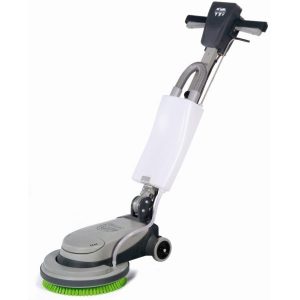
These are entry-level rotaries recommended for domestic, small to medium-sized spaces like offices and retail & bathrooms
Spec:
Brush size: 330 mm / 400 mm
Speed: 200rpm / 150rpm
Motor Power: 400W / 400W
Weight: 18 kg / 18 kg
Power Source: 230V AC 50Hz / 230V AC 50Hz
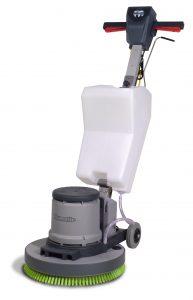
Heavier than the NLL range and with a much stronger motor, these rotaries are versatile and suitable for various applications, ideal for commercial cleaning. There are 4 versions: 150rpm/230rpm/300rpm & 450rpm
Spec:
Brush Size: 450mm
Speed: 150rpm/230rpm/300rpm & 450rpm
Motor Power: 1500W
Power Source: 240V AC 50Hz (there are a limited range of 110/115v too)
Weight: 32kg
Pad Size: 400mm
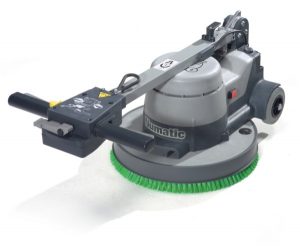
This twin-speed model can rotate at 150rpm or 300rpm. For example, you might start at 150rpm for scrubbing and then increase to 300rpm to get a shine.
Spec:
Brush Size: 450mm
Speed: 150rpm / 300rpm
Motor Power: 1250W
Weight: 40kg
Power Source: 240V AC 50Hz
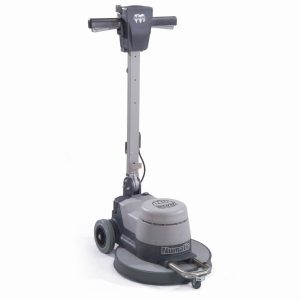
This rotary is a “Burnisher“.
An ultra-high-speed machine specifically designed to attain an ultra-high gloss. The NRU1500 is a 400mm, 16-inch floor burnisher with a speed of 1500rpm.
This type of floor polisher is used in a straight line (like a lawn mower) rather than the side-to-side motion used by other commercial floor machines. It is, therefore, much easier to control. This machine is popular on natural stone floors such as travertine marble & honed limestone.
The NRU1500 will quickly develop a deep gloss on a sealed vinyl floor, but it is not designed to remove large amounts of ingrained dirt.
Spec:
Brush Size: 400mm
Speed: 1500RPM
Motor Power: 1500W
Weight: 32kg
Power Source: 230V AC 50Hz
And with that, you are clued up on the basics of rotaries. 👍
The New Way – Scrubber Dryers
For decades, mopping and traditional floor scrubbing were the primary methods for keeping floors clean. However, just as rotary scrubbers revolutionised floor care in the mid-20th century, a new player has entered the stage – scrubber dryers. In this topic, we’ll explore how scrubber dryers have transformed floor maintenance, their operational mechanics, and their advantages to the cleaning industry.
The Rotary Scrubber’s Successor:
Before the advent of scrubber dryers, rotary scrubbers made floor cleaning more efficient, but there was always the problem of getting the dirty water off the floor. Cleaning a really dirty floor with a rotary was (& is) always a 2 stage process – scrubbing followed by either vacuuming or mopping.
Scrubber dryers offer a 1 stage process, drastically reducing labour time.
How Scrubber Dryers Work:
Scrubber dryers combine scrubbing and drying into one seamless operation.
Here’s a brief overview of how they operate:
- Scrubbing Action: Scrubber dryers are equipped with rotating brushes or pads, the same as rotary scrubbers. These components agitate and remove dirt and grime from the floor.
- Water and Solution Dispensing: Scrubber dryers dispense water and cleaning solution onto the floor through the brush or pad.
- Simultaneous Drying: The machine incorporates a squeegee and vacuum system that collects dirty water and dries the cleaned area. This leaves the floor clean and dry, significantly reducing the risk of slips and falls.
Watch this video of a scrubber dryer in action:
Advantages of Scrubber Dryers:
- Efficiency: Scrubber dryers are highly efficient, covering large areas quickly. They outpace traditional mopping and rotary scrubbers in terms of productivity.
- Versatility: These machines can be used in various settings, from hospitals to warehouses, thanks to their ability to work on different floor types and adapt to specific cleaning needs.
- Enhanced Safety: Scrubber dryers reduce the risk of accidents caused by wet floors, promoting safety in commercial and industrial spaces.
- Hygiene: Scrubber dyers leave floors much cleaner than mopping.
- Conservation: Scrubber dryers typically use less water and cleaning chemicals than traditional methods, aligning with sustainability and eco-friendly practices.
Conclusion:
Scrubber dryers have ushered in a new era of floor maintenance, surpassing the capabilities of rotary scrubbers in many cases. Their efficiency, versatility, and ability to leave floors clean and dry make them essential tools in modern cleaning practices. As the cleaning industry continues to evolve, scrubber dryers stand at the forefront of innovation, ensuring cleaner and safer environments.
Compact Scrubber Dryers
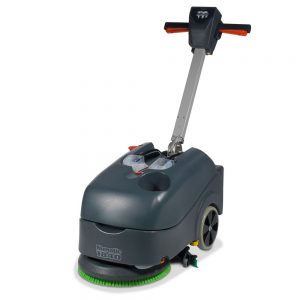
The 1840 is a popular choice for anyone who wants a scrubber dryer but has limited space or is on a budget. The handle folds down for easy storage.
Spec:
Capacity: 18L
Brush Motor: 400W
Vacuum Motor: 300W
Brush Size: 400mm
Brush Speed: 150rpm
Weight (RTU): 56.5kg
Power Source: 230V AC 50Hz
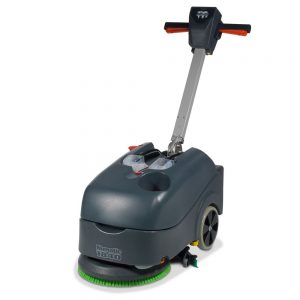
This is the battery version of the 1840. Battery models boast better manoeuvrability and improved health & safety as there is no wire as a trip hazard.
Spec:
Runtime: 60 mins
Vacuum Motor: 100W
Brush Motor: 175W
Power: 36V
Brush Speed: 150rpm
Pad/Brush Width: 360mm / 400mm
Capacity: 18L
Weight: 34kg
Recharge: 1hr / 2hr
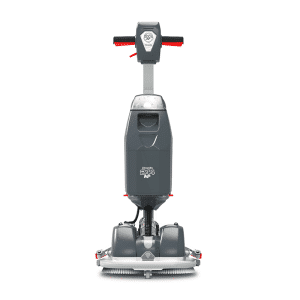
This upright scrubber dryer is the pinnacle of manoeuvrability and can get into areas that most other scrubber dryers could only dream of.
Again, no cable means no trip hazard. it also uses very little water so is great for the environment.
Spec:
Power: 36V
Brush Speed: 140rpm
Pad/Brush Width: 2 x 220mm
Solution Tank: 2.2L
Recovery Tank: 3L
NET Weight: 21.3kg
Runtime: Up to 80mins
Charge Time: 1 hour – 80% / 2 hours – 100%
Pedestrian Scrubber Dryers
A pedestrian scrubber dryer is one you walk behind, pushing and guiding it.
Watch the following video to see how one works and get a glimpse at the scrubber dryers we’re about to go through:
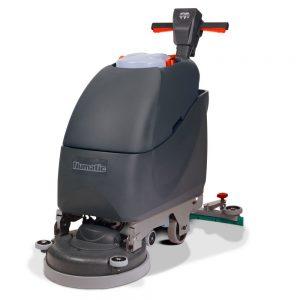
The T4045G is a popular choice for anyone who wants a larger pedestrian scrubber dryer than the 1840 but doesn’t have the budget for a battery machine. The 4045 is a great all-rounder and middle ground.
Spec:
Capacity: 40L
Brush Size: 450mm
Power Source: 240V 50/60Hz
Brush Speed: 150 rpm at 50Hz, 180 rpm at 60Hz
Brush Motor Power: 1500W
Vacuum Motor Power: 1200W
Weight: 67kg
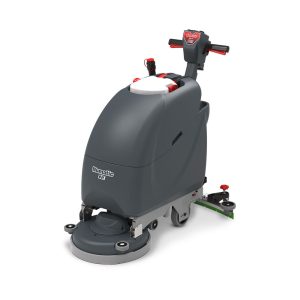
This is the battery version of the 4045. Battery models boast better manoeuvrability and improved health & safety as there is no wire as a trip hazard.
Spec:
Tank Capacity: 40L
Cleaning Width: 55cm
Run Time: 1 Hour 40 Minutes
Charging Time: 2 Hour 30 Minutes
Battery Warranty: 3 Year
Weight: 120kg
Ride-On Scrubber Dryers
As the name suggests, ride-on scrubber dryers are operated by sitting on top of the machine, like a ride-on lawn mower. They are large machines designed for large areas of hard floor. Warehouses and large shopping centres and airports use them.
Watch the following video to see how one works:
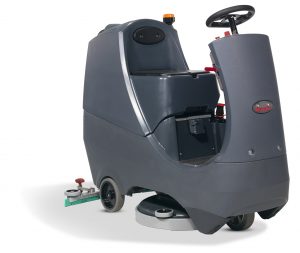
The CRL8055 is the smallest of Numatic’s ride-on machines. Honestly, when it comes to ride-on scrubber dryers, a demonstration is essential. The technician from Numatic will bring the machine to the site, actually clean an area & then talk the customer through the options & features. This is offered free of charge by us through Numatic.
Spec:
Tank Capacity: 80L
Vacuum Motor: 400W
Brush Motor: 600W
Brush Speed: 150rpm
Runtime x1 Battery: 1hr 35mins
Runtime x2 Battery: 3hrs 05mins
Recharge x1 Battery: 2hrs 30mins
Recharge x2 Battery: 5hrs
Deck/Brush Size: 550mm / 550mm
Pad: 508mm
NET Weight x1 Battery: 142.3kg
NET Weight x2 Battery: 153.7kg
Drive Boards & Pads for Scrubbing Machines
All rotaries and scrubber dryers can have multiple brushes for different applications. They can also have their brushes swapped for a drive board that holds pads. The user does this as when it is needed.
Watch the video below to understand how brushes and pads work. This video is not all relevant to the UK but it will at least give you an idea of how many different options there are:
This is our range of brushes for scrubbing machines:
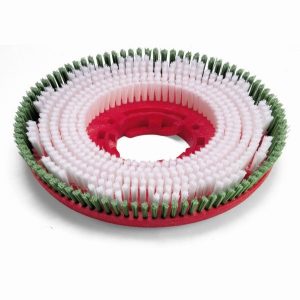
Polyprop Scrubbing Brush: The standard brush. Ideal for scrubbing away dirt and grime, ensuring a thorough clean for various surfaces.
Polypropylene Shampoo Brush: Ideal for gently shampooing and scrubbing of hard floor surfaces.
Union Mix Polishing Brush: Ideal for achieving a brilliant shine on floors.
The polyprop scrubbing brush comes as standard with most machines, the other two are option extras.
Moving onto pads… Pads can be attached to a scrubbing machine by using a drive board. The drive board replaces the brush and has spikes along its surface for a pad to attach to.
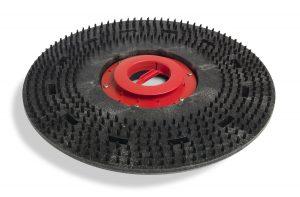
Check out this blog for a more in-depth read into pads.
What To Consider When Buying… A Rotary Scrubber
Investing in a rotary scrubber, also known as a floor buffer or polisher, is a significant decision for anyone involved in floor care. Whether you’re purchasing one for your cleaning business or facility, several crucial factors should guide your decision. In this topic, we’ll explore key considerations when buying a rotary scrubber, including voltage, brush/pad size, RPM (Rotations Per Minute), and weight.
Voltage Requirements:
Check the voltage requirements of the rotary scrubber to ensure it matches the electrical supply available in your facility. Voltage options may vary, so select a machine compatible with your power source to avoid operational issues.
Brush or Pad Size:
Consider the size of the brush or pad that comes with the machine and its suitability for your floor cleaning needs. Larger brushes or pads cover more surface area, potentially reducing cleaning time, but they may be less manoeuverable in tight spaces.
RPM (Rotations Per Minute):
The RPM indicates how fast the rotary scrubber’s brush or pad rotates.
Low speed (eg 150rpm) is good for heavy-duty wet cleaning. A 150rpm will clean very dirty & greasy floors more effectively & they also don’t splash water up the walls & skirtings.
Medium -High Speed = 230-300rpm are best for spray cleaning.
1000-1500rpm are for burnishing.
Ensure the machine’s RPM range aligns with the amount of dirt, the type of floor & the final look the customer wants.
Here’s a general guide for rotary RPMs and their use cases:
Smooth vinyl or laminate floors with scuff marks: Spray clean with red/blue pad and PDQ chemical. 300rpm
Smooth vinyl floor that is very greasy & with ingrained dirt: Wet scrubbing with a green pad & wet vac or mop to pick up the slurry. 150rpm
Safety floor – feels like sandpaper – they are always dirty as the rough texture is designed to grab the soles of feet & therefore dirt!: Wet scrubbing with a micro safety pad (code 150774) & wet vac or mop to pick up the slurry. 150rpm
Penny flooring – this is rubber floor that has raised discs all over it: Wet scrubbing with a scrubbing brush & wet vac or mop to pick up the slurry. 150rpm
A tiled floor with grout lines or a natural slate floor that is very dirty: Wet scrubbing with a scrubbing brush & wet vac or mop to pick up the slurry. 150rpm
A slate, flagstone, wooden or terracotta floor that the customer wants a shine on: Spray clean with a polishing brush and PDQ chemical. 300rpm
A marble or stone floor that is smooth with scuff marks & the occasional light spillage: Spray clean with red/blue pad and PDQ chemical. 300rpm
A slightly textured or smooth porcelain floor or any other difficult floor where the dirt is ingrained into the floor & difficult to remove. Some floors have micropores ie tiny holes that dirt gets trapped in. The floors always have a grubby appearance: Spray clean or wet clean with a melamine pad or a twister (diamond dust) pad. 150-300rpm
A marble or vinyl floor that is smooth, and relatively clean where the customer wants a high gloss finish: Burnish with a white pad & Renew TD. 1000-1500rpm
A vinyl floor that has been sealed with a floor polish that needs stripping off & reapplying & then maintaining: Use a twin-speed machine set at 150rpm with a black pad & stripping chemical to remove the polish. Once the polish has been reapplied. Maintain at 300rpm by spray cleaning with red/blue pad and PDQ chemical. Twin Speed
Weight and Maneuverability:
Evaluate the weight of the rotary scrubber. A heavier machine offers better scrubbing power but can is difficult to get upstairs. Most rotaries spin from side to side, so are impractical for small rooms with lots of furniture.
Budget:
Budget can often be a determining factor when it comes to what scrubbing machine you buy. Remember if you have spent £1,000’s on a floor then you should expect to buy a machine that is fit for purpose. You wouldn’t buy Bentley Continental & then fit cheap remold tyres on it!
If floors are maintained properly they will look better day to day & it will be longer before they need replacing.
Warranty and Customer Support:
A warranty provides assurance of product quality, while accessible customer support can help address any operational or maintenance issues. For example, Numatic rotaries come with a 2-year warranty.
Conclusion:
When purchasing a rotary scrubber/polisher, a thorough evaluation of these factors is essential to make an informed decision. Ensuring compatibility with your facility’s electrical supply, assessing brush or pad size, RPM, weight, and considering long-term costs will help you select the right machine for your floor cleaning needs. Ultimately, a well-chosen rotary scrubber can streamline your floor care processes and contribute to cleaner, safer environments.
What To Consider When Buying… A Scrubber Dryer
Investing in a scrubber dryer is a substantial purchase. Whether it’s for your own building or you are being paid to maintain someone else’s building, you presumably want it to look as clean as possible, as fast as possible & to be as safe as possible. To ensure you make the right choice, it’s crucial to consider the following key factors:
Size and Capacity:
Begin by evaluating the size and capacity of the scrubber dryer. Consider the dimensions of the machine and its tank capacity for holding dirty water and cleaning solution. Ensure it can efficiently cover the floor space you need to clean without constant refilling. Also, consider where it’s going to be stored & whether it needs to be carried upstairs.
Where will the Dirty Water Go?:
Consider where the dirty water will be drained. Maybe you have a floor drain? In this case, choose a machine with a dump hose that drops down & uses gravity to empty the tank. If the dirty water must be deposited down a sluice or toilet, choose a machine with a removable tank.
Where will the clean water come from?
A garden hose is the best way to fill up larger machines. Smaller machines have removable tanks that will fit under some taps. Do not buy a huge machine & then have to fill it up with a bucket!
Cleaning Width:
The cleaning width of a scrubber dryer’s brush or pad determines how much area it can cover in a single pass. A wider cleaning width can increase productivity by reducing the required passes. However, it’s essential to balance this with the machine’s manoeuvrability in tight spaces.
Power Source:
Determine the power source for the scrubber dryer. Some models are battery-powered, offering cordless operation for greater freedom of movement. Others are plug-in electric machines. Consider the availability of power outlets in your facility and whether cordless operation is essential for your needs. Battery machines are much safer as trailing cables create a substantial trip hazard. So, if the cleaning is being done during the day & there are customers or staff members in the building, DO NOT use a mains machine……it would be a lawsuit waiting to happen!
Manoeuvrability:
Evaluate the machine’s manoeuvrability, especially if you need to clean in confined or congested areas. Consider factors like the machine’s weight, design, and ease of steering. A manoeuvrable scrubber dryer can enhance efficiency and reduce operator fatigue. Scrubber dryers nearly always need to be used like a lawn mower in a forward motion, not like a Flymo back & forth. This is because the squeegee needs to pick up what the scrubbing brush has just left behind. Try to picture the path the machine could take in your room.
Budget:
Budget can often be a determining factor when it comes to what scrubbing machine a customer buys. Like battery cars, battery scrubber dryers are the more expensive option.
Remember:
We can get all Numatic floor machines demonstrated. This is the best way to check that the machine suits your requirements.
Warranty and Customer Support:
A warranty gives you confidence in the machine’s quality, while accessible customer support can assist with any operational or maintenance issues. For instance, Numatic scrubber dryer models come with a 2-year warranty.
Conclusion:
When purchasing a scrubber dryer, a comprehensive assessment of these factors is essential for making an informed decision. Ensuring the machine’s size, cleaning width, power source, brush or pad options, manoeuvrability, and budget align with your specific floor cleaning requirements is crucial. A well-chosen scrubber dryer can streamline your floor care processes, contribute to cleaner environments, and ultimately provide value for your investment.
====
Do you have any top tips, or cleaning hacks you’d like to share?

Follow us on our socials and let us know:

